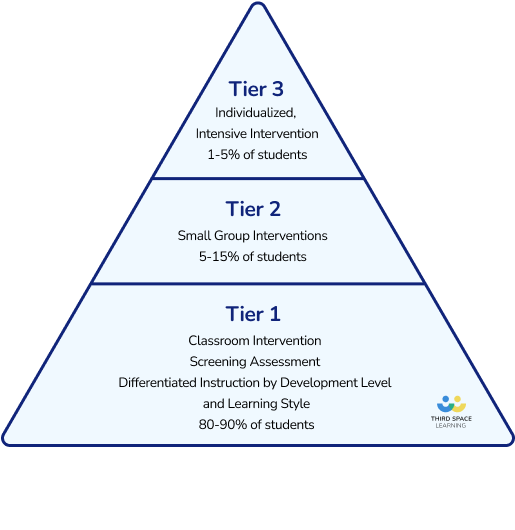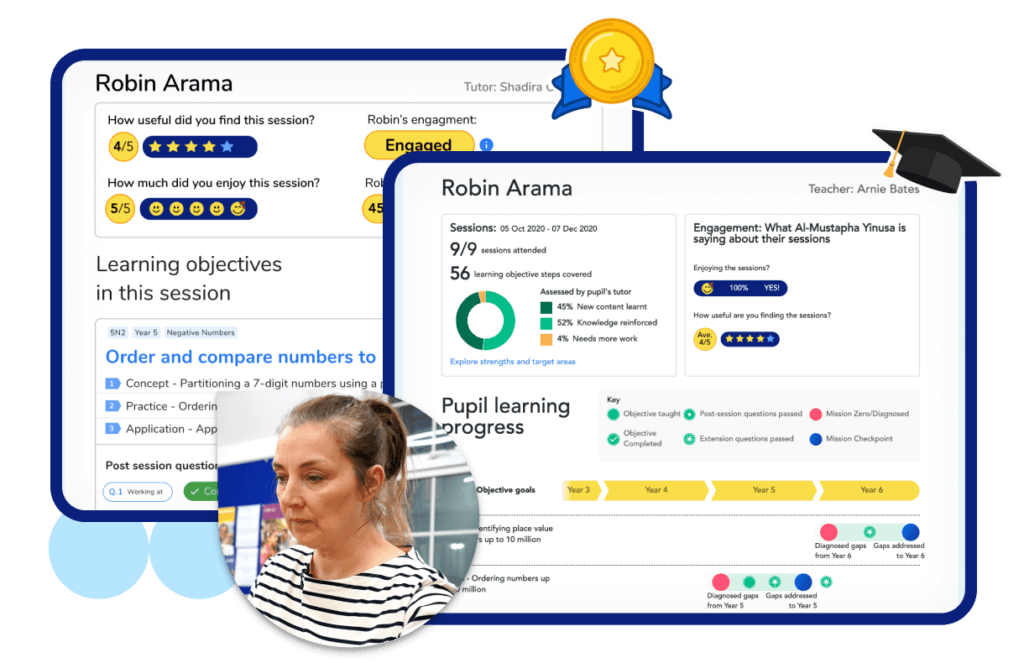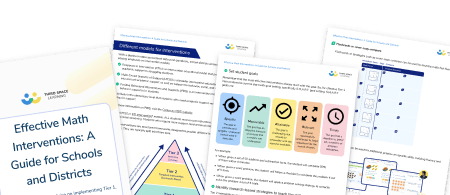What Is Math Intervention? A Comprehensive Guide To What It Is And 7 Best Math Intervention Practices
Not all students find math easy, some will need a math intervention or extra math program to keep up. Whether this extra support is provided by math interventionists in school or class teachers, this guide will help you support students improve their math skills.
If you’re not a specialist math interventionist, it can be overwhelming knowing where to start when implementing math interventions for students.
Many math intervention myths add to this overwhelm. This article will help to debunk these myths and provide a deeper understanding of math interventions.
Discover practical tips and guidance to help you implement successful interventions from elementary through to high school.
What is math intervention?
Math intervention is a targeted instructional approach to math. It is designed to provide additional support and assistance to students who struggle with math skills and concepts.
In short, math interventions help students who are behind in their math learning and may need support from MTSS or RTI. This specialized form of education aims to identify and address specific challenges that individuals face in understanding and applying math.
Math intervention programs are implemented to help:
- Close learning gaps
- Secure math skills
- Promote a deeper comprehension of mathematical concepts
What is the goal of math intervention?
Schools and districts use math intervention to:
- Address gaps in grade-level knowledge
- Boost math progress
- Promote math proficiency
Math interventions will have different goals and need to be personalized based on the students receiving the instruction.
By using personalized and differentiated instruction for reteaching math strategies, educators can:
- Help students progress in math
- Build confidence
- Develop mathematical skills
Students who struggle with math can often dislike and disengage from lessons. Extra math support provides the opportunity to build on math skills and develop a love of math.
Effective Math Interventions: A Guide for School Leaders
Everything you need to know about tiered interventions, covering Tier 1, Tier 2, and Tier 3, with free resources and research-based strategies for use in the classroom
Download Free Now!What is a child-friendly definition of math intervention?
Grade K students may not understand what a math intervention is or why they need one. If extra math programs take place away from the classroom, having a child-friendly definition of math interventions to explain what is happening can help.
Math intervention is like having a special helper – either a teacher or a tool – that gives you extra support and cool tricks to make learning math easier and more fun.
Who needs a math intervention?
When students encounter difficulties that hinder their math progress, it’s time to implement a math intervention.
Students may face challenges in math when there are:
- Diverse learning styles
- A lack of number sense
- Gaps in prior knowledge
- Difficulties in grasping abstract math concepts such as fractions
Math intervention programs can begin as early as grade k and elementary school if these challenges are identified early on. Tutoring for math interventions can take place during the school year or as a summer tutoring program.
Each math intervention should be tailored to the unique needs of individual students and use a range of instructional strategies, resources, and formative assessment tools to facilitate targeted learning.
Other children who could need a math intervention include:
- Struggling students
- Students with learning difficulties
- English Language Learners (ELL)
Struggling students
Individuals who experience math anxiety can have difficulty grasping fundamental mathematical concepts. If they struggle with basic arithmetic skills, they may benefit from a math intervention.
Equally, students who consistently perform below grade level in mathematics or are identified as two grade levels or more behind may require math interventions. Assessment of grade level standards can be essential in identifying these students.
When students reach middle school, these performance gaps tend to become more obvious. Diagnostic assessments throughout elementary are essential for early Response To Intervention.
Students with learning differences
Specific learning disabilities can negatively impact mathematical processing. Additional needs such as dyscalculia can affect a student’s numeracy and mathematical comprehension.
Indicators like these highlight students who may need an additional math program outside of whole class instruction to improve fact fluency and confidence.
Students who have learning difficulties but are not identified as requiring special education are often ideal candidates for mathematics intervention.
English Language Learners (ELLs)
Children with English as a second language will often benefit from a math intervention. An extra math program could help ELLs overcome language barriers within the math curriculum such as:
- Key math terminology
- Understanding word problems.
- Developing math proficiency
- Problem-solving
Using graphic organizers and visual math facts for each math topic can be particularly helpful in accelerating math progress for ELL students.
Research-based math intervention programs
Every math intervention program implemented by a school or district needs to be well-researched. Interventions must be evidence-based and prove they positively impact a student’s mathematical outcomes.
Often, these programs focus on individualized instruction, differentiation, and targeted support.
Response to intervention (RTI) is an example of a research-based intervention program that bridges the gap between the general education classroom and mathematics intervention through early intervention.
RTI is a tiered system of support, with increasing levels of intensity based on individual student needs:
- Tier 1 — whole group strategies in the general classroom
- Tier 2 — specialized small group instruction
- Tier 3 — targeted individualized instruction
Response to intervention emphasizes the use of data-driven decision-making to monitor student progress and adjust interventions as needed.
All three tiers can be implemented across all grade levels, including elementary, middle, and high school.

Math intervention strategies
Successful math interventions use evidence-based strategies to improve students’ mathematical abilities.
A range of evidence-based math intervention strategies are available for math teachers to support students’ progress. Some examples of math intervention strategies used in schools include.
- Diagnostic assessments help to identify gaps in knowledge.
- Regular testing assesses the success of the intervention
- Hands-on activities and manipulatives
- Visual resources to improve conceptual understanding
- Small group work for individualized instruction
Math intervention: 7 best practices
Implementing an intervention won’t automatically boost student progress. But there are certain practices that contribute towards implementing successful interventions.
Here are 7 best practices to ensure your math interventions are effective:
1. Early intervention
Often, it can be tempting to hope students will catch up and leave interventions until middle school or high school.
The earlier math difficulties are detected and the response to intervention begins, the better. Start math intervention in elementary school to help students avoid larger difficulties with math later on.
2. Diagnostic assessment
Diagnostic assessments are a helpful tool to identify struggling students and the appropriate math interventions that need to be put in place.
Based on diagnostic assessment results, students might require personalized math intervention. This additional math program should cater to the math strands they need help with most.
Ongoing student assessments are a helpful form of progress monitoring. They ensure the math interventions are working for students as well as identifying areas for further support, they highlight areas of improvement
4. Engaging instruction
Often, students disengage with instruction if they struggle with the topic. Making math tutoring engaging can help boost student progress. Using technology, manipulatives, visuals and hands-on activities can help to promote student engagement.
Providing students with meaningful, personalized math instruction helps to break down more complex concepts to help students grasp a better understanding of the topics they struggle with.
If math tutoring is personalized, students will better relate concepts to real-life situations and engage with the learning.
Third Space Learning’s one-on-one math tutoring is personalized for each student. Ongoing diagnostic assessments from highly qualified math specialist tutors allows personalized instruction in real time.
Personalized one-on-one math instruction means students focus on the math topics they struggle with most, helping to accelerate math growth.
5. Evidence-based interventions
Ensure you use evidence-based strategies when implementing math interventions. Don’t waste time on approaches that may or may not work.
Using interventions backed by data to show student progress increases the likelihood of your students making progress too.
6. Small groups
Carrying out math interventions in small groups allows instruction to be personalized to a group of students’ specific needs.
Small groups also mean students can receive instant feedback on work as opposed to losing context and meaning while waiting for feedback in whole class learning.
7. Involve parents
Keeping parents and carers informed and involved with interventions helps support math outside the classroom.
Parental involvement can contribute towards a positive learning environment and boost math progress.
Educators can effectively support students’ math progress by incorporating these best practices into their interventions.
Read more: 18 FREE math intervention resources
How can Third Space Learning support math interventions?
Third Space Learning provides one-on-one math tuition for the students who need it most.
No one knows your students like a teacher does so schools decide which standards each student needs additional practice with each week.
Each one-on-one math lesson is designed to close learning gaps and address misconceptions and high-quality math tutors personalize the pitch and pace to fit each student.
Ongoing diagnostic assessment from highly trained stem specialist tutors identifies areas students need to work on. And highlights the progress they have made.
After each session, teachers receive a detailed report for each student, showing topics covered, skills practiced and progress made.

FAQs
Here are 5 examples of intervention strategies:
1. Diagnostic assessments: Begin with thorough diagnostic assessments to identify specific areas of mathematical difficulty for each student, allowing for targeted intervention addressing individual needs.
2. Individualized instruction: Tailor interventions with personalized plans based on diagnostic assessments, recognizing and addressing specific learning styles, strengths, and weaknesses to promote a more effective and targeted learning experience.
3. Progress monitoring: Regularly monitor and assess students’ progress to gauge the effectiveness of interventions, ensuring timely adjustments and celebrating small successes to boost confidence and motivation.
4. Small group instruction: Implement small group instruction to facilitate personalized interactions, immediate feedback, and a collaborative learning environment, enhancing the effectiveness of targeted support.
5. Technology integration: Utilize educational technology to engage students, provide additional practice opportunities, and offer adaptive software that tailors interventions to individual learning needs.
Evidence-based math intervention strategies draw on research-supported methods to address learning challenges effectively. These strategies often include diagnostic assessments to identify specific areas of difficulty, allowing for targeted interventions. Individualized instruction, progress monitoring, and the integration of technology are common features, providing personalized support, continuous assessment, and engaging tools for a more comprehensive and impactful learning experience.
Math intervention employs three key approaches to support students facing challenges in mathematical learning. First, diagnostic assessments play a pivotal role by thoroughly identifying specific areas of difficulty for each student. These assessments serve as a starting point for targeted interventions, addressing individual needs effectively. Second, the approach emphasizes individualized instruction, tailoring interventions with personalized plans based on diagnostic assessments. This recognizes and addresses diverse learning styles, strengths, and weaknesses to create a more impactful and personalized learning experience. Third, progress monitoring is crucial for ensuring the effectiveness of interventions. Regular assessments allow educators to gauge students’ progress, make timely adjustments, and celebrate small successes, ultimately boosting confidence and motivation. By combining these three approaches, math intervention seeks to provide comprehensive and tailored support, fostering a positive and successful mathematical journey for every student.





